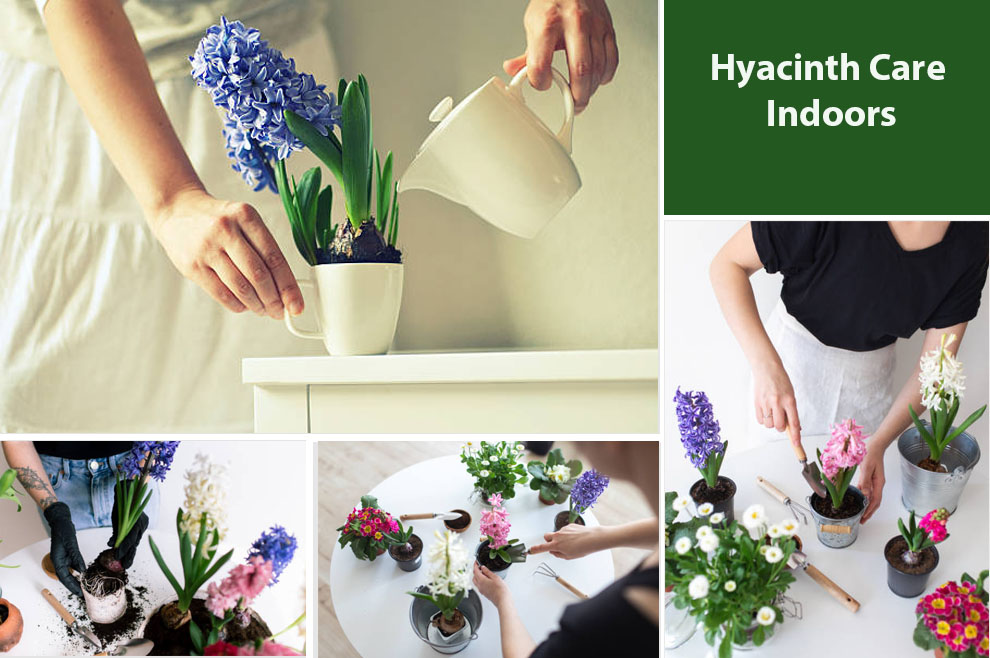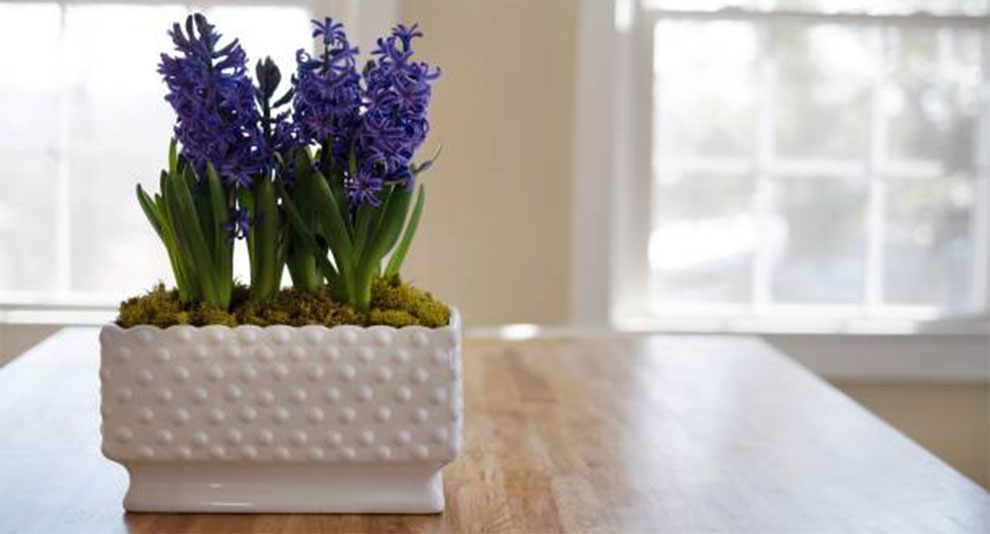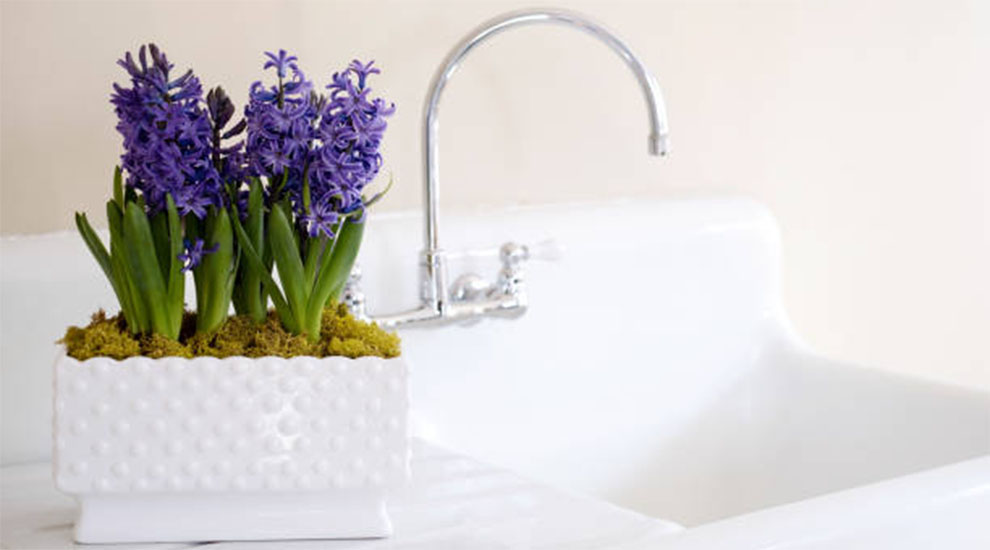How To Take Care Of Hyacinth Indoors
For indoor hyacinth care, provide them indirect sunlight, use well-draining soil. Soil must be moist but not soggy. Maintain 60-65°F (15-18°C). Feed with balanced fertilizer every 2-4 weeks while growing.

Hyacinths, with their beautiful clusters of fragrant blooms, bring a touch of springtime charm regardless of where they grow.
While traditionally linked to the outdoor gardens, these delightful blooms can thrive indoors, gracing your home with their sweet scent and beauty.
But how to take care of hyacinths indoors to ensure they flourish in the environment?
Firstly, you must provide them with a favorable environment to grow. From diligent watering to proper indirect light exposure and periodic fertilization every 2-4 weeks, everything is crucial for nurturing healthy hyacinths.
Let us delve into details and learn how to create a nurturing environment for these beautiful blooms.
Can Hyacinths Live Indoors?
Yes.
Hyacinths can thrive indoors, bringing a sweet fragrance and appealing beauty to your living space.
With the proper care, these beautiful flowers can flourish in containers and pots, making them a delightful addition to your indoor space.
Regular watering, ample light, and well-draining soil can ensure their success.
Further, a period of cold dormancy following bloom appearance will rejuvenate them for subsequent growth.
With proper care and attention, you can enjoy the delightful beauty of hyacinths around the year, even within the confines of your home.
Hyacinth Care Indoors
Below, we will take you through a comprehensive guide on caring for hyacinths indoors, ensuring they thrive and bring a vibrant beauty to your living space.
1. How do you plant hyacinth bulbs in a pot?
Picking the appropriate container is vital for successful hyacinth indoor care. You must select a pot that is about six to eight inches deep.
Further, it should have drainage holes to avoid waterlogged soils. Opt for a well-draining potting mix with equal parts of sand or perlite to ensure root aeration.
When planting the hyacinth bulbs, position them in a way their pointed end faces upward, and the flat face rests on the soil.
Ensure proper space between bulbs. Ideally, two to three inches will suffice for healthy root development.
Further, settle the bulbs securely into the soil with their tops protruding. It will help avoid moisture accumulation around the bulb, lowering the risk of root rot.
You will lay a solid foundation for your indoor plants by following these steps, promoting vibrant blooms and healthy growth.
2. What type of soil do hyacinths grow best indoors?
The best soil for indoor hyacinths is a well-draining potting mix. The soil must be rich in organic matter and offer adequate aeration for the roots.
For hyacinth care indoors the soil must have equal parts of standard potting soil, coarse sand, and perlite. This combination ensures the excess water drains away effectively, preventing the bulbs from sitting in waterlogged soil, which may result in root rot.
Further, the organic matter in the potting mix offers vital nutrients for healthy growth. Always pick a top-quality, sterile potting mix to lower the susceptibility of soil-borne pests and diseases.
3. Do indoor hyacinths need light?
Hyacinths thrive in indirect, bright sun when grown indoors. They cherish a location receiving at least four to six hours of direct sun daily.
You can put them near a south-facing window where they receive adequate filtered sunlight.
If the natural light is insufficient, you can supplement it with artificial growth lights designed for flowering bulbs. Please know hyacinths are sensitive to high temperatures.
So, please do not place them near heat sources or direct sun. You can occasionally rotate the pot to provide an even light exposure.
It helps achieve balanced growth and ensures the plant does not lean towards a light source. Offering the correct light conditions is necessary for a flourishing indoor hyacinth.
4. Where should hyacinths be placed indoors?

When picking a location for the indoor hyacinths, look for a spot that offers bright, indirect light. A south-facing window is usually ideal, as it provides ample natural light.
But please be cautious of the intense afternoon sun, which gets too harsh.
When a south-facing window is absent, a west or east-facing window can also work, but they will need some adjustments to ensure the correct dose of light.
Do not keep the hyacinths near heating vents or radiators, as excessive warmth can be detrimental.
Further, keep them away from drafty areas, as sudden temperature fluctuations can stress the plant. Providing the right location sets the stage for vibrant and healthy growth.
5. When should I water my indoor hyacinths?
Proper watering is a crucial aspect of hyacinth care indoors. Ideally, let the top soil inch dry out before watering. It should take around seven to ten days.
When watering, ensure absolute saturation, allowing the excess water to drain from the pot’s bottom.
Discard any accumulated water in the saucer to avoid waterlogging. Be cautious not to let the bulbs sit in standing water, as it may result in root rot.
After flowering, the plant enters dormancy. You can reduce watering for the plant to enter a rest phase. Watering adjustments based on specific environmental conditions can help with growth.
So, following this general guideline can help maintain the optimal soil moisture levels for healthy hyacinth growth.
6. What temperature & humidity can hyacinths tolerate indoors?

Maintaining suitable humidity and temperature levels is imperative for indoor hyacinths’ health.
They prefer cooler temperatures while actively blooming and growing. Try for a temperature between 60-65°F (15-18°C) during this period.
Once they start flowering, they can endure a higher temperature. However, do not expose them to extreme heat.
Hyacinths do not need high humidity levels. Average indoor humidity typically suffices.
If your home is dry, especially during the temperature drops, you can use a humidifier to cover the moisture deficit.
But do not mist the plant directly, as it may result in fungal growth and molds on the bulb.
You can create a conducive environment where indoor hyacinths flourish and thrive by maintaining suitable humidity and temperature.
7. What is the best Fertiliser for hyacinths indoors?
Fertilizing indoor hyacinths is vital to ensure the plant receives the nutrients mandatory for vibrant blooms and robust growth.
You can start feeding when you first see the green shoots emerging from the soil in the early spring. Use a water-soluble, balanced fertilizer with equal NPK (nitrogen, phosphorus, potassium) ratios.
Alternatively, a specialized bulb fertilizer can also be a good choice. Dilute the fertilizer to half the recommended strength and apply it every two to four weeks during the active growth.
Stop feeding the plant once the blooms fade and the plant enters dormancy. It lets the hyacinth naturally prep for the next growth cycle.
You can begin feeding when new growth appears in the following spring. Proper feeding, with other care practices, can help your indoor hyacinth thrive and offer a burst of fragrance and color to the living space.
How To Take Care Of Hyacinth Plant Indoors After Flowering?
After the indoor hyacinth finishes flowering, they transition to a dormant phase. So, trim the spent flowers, leaving the foliage intact.
Place the plants in a cooler location (preferably around 50-55°F (10-13°C) with reduced sunlight access.
Gradually lower the watering to ensure the plant enters dormancy naturally. After the foliage begins to turn yellow and withers, you can remove them gently.
Next, store the bulbs in a dark but cool place for at least eight to ten weeks, ensuring they rest well. Once ready, repot or bring them back to a brighter environment to initiate the next growth cycle.
Following this post-flowering care helps promote repeat, healthy blooms in the future.
Related: How to grow hyacinth bulbs in water
How Do You Save A Dying Hyacinth Plant Indoor: Hyacinth Problems & Treatments
Indoor hyacinths may encounter some common issues. However, with prompt attention, they can be addressed easily.
- Yellowing leaves signify overwatering. So, adjust the watering for good hyacinth care indoors.
- The plant may require more light if the leaves are spindly or pale. To overcome this, you can shift it to a brighter spot.
- Fungal diseases like gray mold may arise in humid conditions. You can tackle pests like aphids by gently applying insecticidal soap or spraying the plant with water.
- Bulbs rotting in waterlogged soil signify poor drainage. So, consider repotting them in well-draining soil.
- Lastly, if the flower spikes droop, provide support with stakes. Timely intervention and regular monitoring can help keep indoor hyacinths thriving and healthy.
